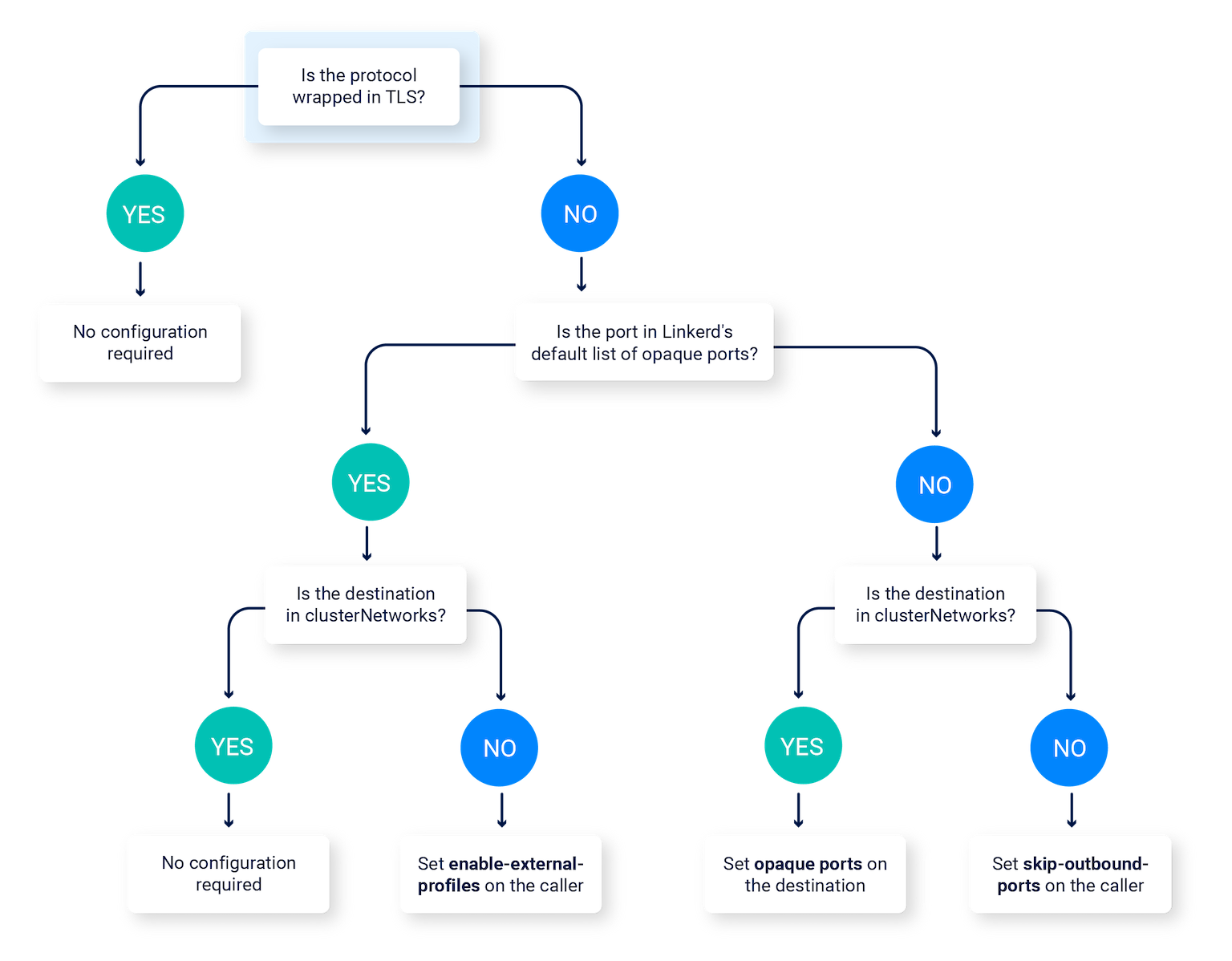TCP Proxying and Protocol Detection
Linkerd is capable of proxying all TCP traffic, including TLS connections, WebSockets, and HTTP tunneling.
In most cases, Linkerd can do this without configuration. To accomplish this, Linkerd performs protocol detection to determine whether traffic is HTTP or HTTP/2 (including gRPC). If Linkerd detects that a connection is HTTP or HTTP/2, Linkerd automatically provides HTTP-level metrics and routing.
If Linkerd cannot determine that a connection is using HTTP or HTTP/2, Linkerd will proxy the connection as a plain TCP connection, applying mTLS and providing byte-level metrics as usual.
(Note that HTTPS calls to or from meshed pods are treated as TCP, not as HTTP. Because the client initiates the TLS connection, Linkerd is not be able to decrypt the connection to observe the HTTP transactions.)
Configuring protocol detection
In some cases, Linkerd’s protocol detection will time out because it doesn’t see any bytes from the client. This situation is commonly encountered when using protocols where the server sends data before the client does (such as SMTP) or protocols that proactively establish connections without sending data (such as Memcache). In this case, the connection will proceed as a TCP connection after a 10-second protocol detection delay.
To avoid this delay, you will need to provide some configuration for Linkerd. There are two basic mechanisms for configuring protocol detection: opaque ports and skip ports:
- Opaque ports instruct Linkerd to skip protocol detection and proxy the connection as a TCP stream
- Skip ports bypass the proxy entirely.
Opaque ports are generally preferred as they allow Linkerd to provide mTLS, TCP-level metrics, policy, etc. Skip ports circumvent Linkerd’s ability to provide security features.
Linkerd maintains a default list of opaque ports that corresponds to the standard ports used by protocols that interact poorly with protocol detection. As of the 2.12 release, that list is: 25 (SMTP), 587 (SMTP), 3306 (MySQL), 4444 (Galera), 5432 (Postgres), 6379 (Redis), 9300 (ElasticSearch), and 11211 (Memcache).
Protocols that may require configuration
The following table contains common protocols that may require additional configuration.
| Protocol | Standard port(s) | In default list? | Notes |
|---|---|---|---|
| SMTP | 25, 587 | Yes | |
| MySQL | 3306 | Yes | |
| MySQL with Galera | 3306, 4444, 4567, 4568 | Partially | Ports 4567 and 4568 are not in Linkerd’s default set of opaque ports |
| PostgreSQL | 5432 | Yes | |
| Redis | 6379 | Yes | |
| ElasticSearch | 9300 | Yes | |
| Memcache | 11211 | Yes |
If you are using one of those protocols, follow this decision tree to determine which configuration you need to apply.

Marking ports as opaque
You can use the config.linkerd.io/opaque-ports annotation to mark a port as
opaque. Note that this annotation should be set on the destination, not on the
source, of the traffic.
This annotation can be set in a variety of ways:
- On the workload itself, e.g. on the Deployment’s Pod spec receiving the traffic.
- On the Service receiving the traffic.
- On a namespace (in which it will apply to all workloads in the namespace).
- In an authorization policy
Serverobject’sproxyProtocolfield, in which case it will apply to all pods targeted by thatServer.
When set, Linkerd will skip protocol detection both on the client side and on the server side. Note that since this annotation informs the behavior of meshed clients, it can be applied to unmeshed workloads as well as meshed ones.
Marking ports as skip ports
Sometimes it is necessary to bypass the proxy altogether. In this case, you can
use the config.linkerd.io/skip-outbound-ports annotation to bypass the proxy
entirely when sending to those ports. (Note that there is a related annotation,
skip-inbound-ports, to bypass the proxy for incoming connections. This is
typically only needed for debugging purposes.)
As with opaque ports, multiple skip-ports can be provided as a comma-delimited string.
This annotation should be set on the source of the traffic.
Setting the enable-external-profiles annotation
The config.linkerd.io/enable-external-profiles annotation configures Linkerd
to look for ServiceProfiles for off-cluster
connections. It also instructs Linkerd to respect the default set of opaque
ports for this connection.
This annotation should be set on the source of the traffic.
Note that the default set of opaque ports can be configured at install
time, e.g. by using --set proxy.opaquePorts. This may be helpful in
conjunction with enable-external-profiles.
Using NetworkPolicy resources with opaque ports
When a service has a port marked as opaque, any NetworkPolicy resources that
apply to the respective port and restrict ingress access will have to be
changed to target the proxy’s inbound port instead (by default, 4143). If the
service has a mix of opaque and non-opaque ports, then the NetworkPolicy
should target both the non-opaque ports, and the proxy’s inbound port.
A connection that targets an opaque endpoint (i.e a pod with a port marked as opaque) will have its original target port replaced with the proxy’s inbound port. Once the inbound proxy receives the traffic, it will transparently forward it to the main application container over a TCP connection.

